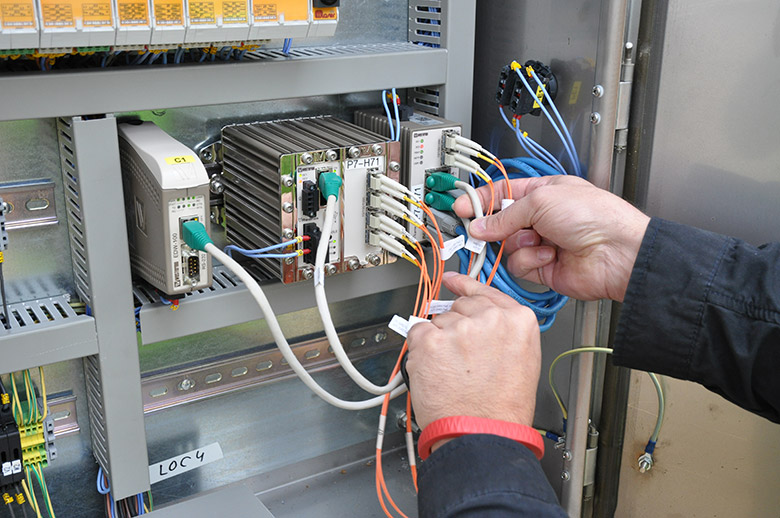Software tools simplify data network configuration

For system integrators, completing projects on time and budget is obviously critical, but can often be hampered by limited in-house experience of designing, engineering and configuring resilient data communication networks. Data communications are now omnipresent, used within most functions of everyday life and essential for industrial systems implemented across different applications and industries. However, within the context of implementing, for example a new rail track monitoring system or power distribution network, the importance of data communications can often be underestimated, along with the amount of time and cost required to configure a secure network. It’s not unusual for the number of man-hours required to implement a new communications network to far exceed what was originally budgeted for and impacting overall project profitability.
Most industries are adopting IP-based Ethernet networks to support their data communications requirements and the size and complexity of these networks is increasing. To meet the growing need to connect a more diverse range of equipment across wider geographical areas, networks are larger and may include a mix of wired and wireless technologies. Reliability, availability and cybersecurity are priorities, which has created greater network complexity, with different topologies deployed, such as fast recovering redundant rings, and a growing number of protocols such as MRP, STP and RSTP that help to provide greater functionality and enhance network security.
Manually configuring network devices
Having designed and constructed the network, often working closely with a technology vendor, a system integrator will be required to configure the devices forming the network. Typically, a network consisting of 300 Ethernet switches might take a couple of weeks to configure, and consume a significant amount of man-hours. The task would require a system engineer to perform the configuration manually, physically or virtually connecting to each network device in turn and implementing the appropriate settings. Not only is this process very laborious and time-consuming, but it also introduces the possibility of human error that would require troubleshooting and add additional time to the project. Correct configuration is critical, not only to ensure the network operates successfully, but also to maximise the security of the network. For example, it is very important that factory set passwords have been changed for every device and all unused ports have been closed to minimise vulnerability to cyber threats.

Configuration tools
As networks expand in size and complexity, the need for easy, fast and secure configuration therefore increases. To meet this requirement, network configuration tools has been developed that allow the task to be performed both quickly and accurately. Using these tools, the repetitive and time-consuming manual tasks can be automated and complex configurations can be deployed with just a few clicks. Instead of weeks to configure a network with 300 switches, the task can be done in hours. Moving away from a manual process also helps to minimise the risk of configuration errors, which reduces the time required to troubleshoot and optimises network security. Network configuration tools can help to produce good documentation that is valuable at system handover or a site acceptance test. Once a network has been configured, a deployment report can be automatically generated. This document usually includes a network map and information on each network device and link.
Cybersecurity
Network configuration tools also have features that bolster cybersecurity. For example, they can be used to perform a security analysis and will suggest changes that are needed to the network. It is possible to scan and then harden the security features of switches with factory default passwords or which use unsecure protocols. A system wide security configuration can be applied quickly and easily. Network configuration tools also enable users to configure and maintain cyber security features over the lifecycle of the network. Powerful spoofing protection features, such as MAC address filters and the configuration of IEEE802.1x port access authentication can be easily deployed and maintained. This helps to prevent unauthorised access to the network.
Network lifecycle
A properly configured and monitored network with simple and robust maintenance processes will minimise any risk of network downtime. Network configuration tools not only simplify the initial installation and configuration of single or multiple network devices, but also support ongoing maintenance through the life of the network. Once devices are configured and the network commissioned, a back-up of all the device configuration files can be easily made and stored. In the event that a switch or router needs to be replaced in service, the saved configuration can be downloaded to the new unit, resulting in a faster network repair, helping to save time for maintenance engineers. Network configuration tools also enable configuration updates to be deployed in bulk.
Conclusion
Using network configuration tools both for the initial configuration and the ongoing maintenance after commissioning can save hundreds of man hours over the lifetime of a network. Automating previously time-consuming repetitive tasks, not only saves valuable time for system integrators, but offers their customer long-term operational benefits in terms of network availability and security.
Alan Bollard
Managing Director, Westermo UK
See also

Time-saving configuration tool
WeConfig makes network configuration and maintenance more efficient, simple and reliable.

Easy and secure remote access
Remote access any device on your network from anywhere in the world. Secure, robust and effective.

Cyber resilient operating system
WeOS combines ease of use with routing, cybersecurity, VPN and sophisticated switch functionality.
Carl de Bruin
International sales

For support inquiries, click here to contact Technical Support

